NRSG353 Case Study: Comprehensive Analysis of Heart Failure (CHF)
VerifiedAdded on 2023/04/08
|11
|2140
|119
Case Study
AI Summary
This nursing case study focuses on a patient, Mrs. Sharon McKenzie, suffering from Congestive Heart Failure (CHF). The analysis covers the causes of CHF, including abnormal heart rhythms, hypertension, and cardiac enlargement, as well as incidents and risk factors such as sudden heart attacks and coronary artery diseases. It discusses the impact of CHF on the patient and her family, highlighting physical and mental health implications. The study identifies symptoms like swollen ankles, shortness of breath, and low potassium levels, detailing the pathophysiology of heart failure including ventricular arrhythmias and hypokalemia. Furthermore, it explores relevant drug classes such as ACE inhibitors and beta-blockers, explaining their pharmacokinetics and pharmacodynamics. Finally, a nursing care plan is presented, emphasizing regular body check-ups, a peaceful environment, proper dieting, timely medication, and monitoring of urine output and other vital signs to manage the patient's condition effectively. Desklib provides a platform to explore more such case studies and assignments.

Nursing Assignment 1
NRSG353 Assessment Task 1- Case Study
NRSG353 Assessment Task 1- Case Study
Paraphrase This Document
Need a fresh take? Get an instant paraphrase of this document with our AI Paraphraser
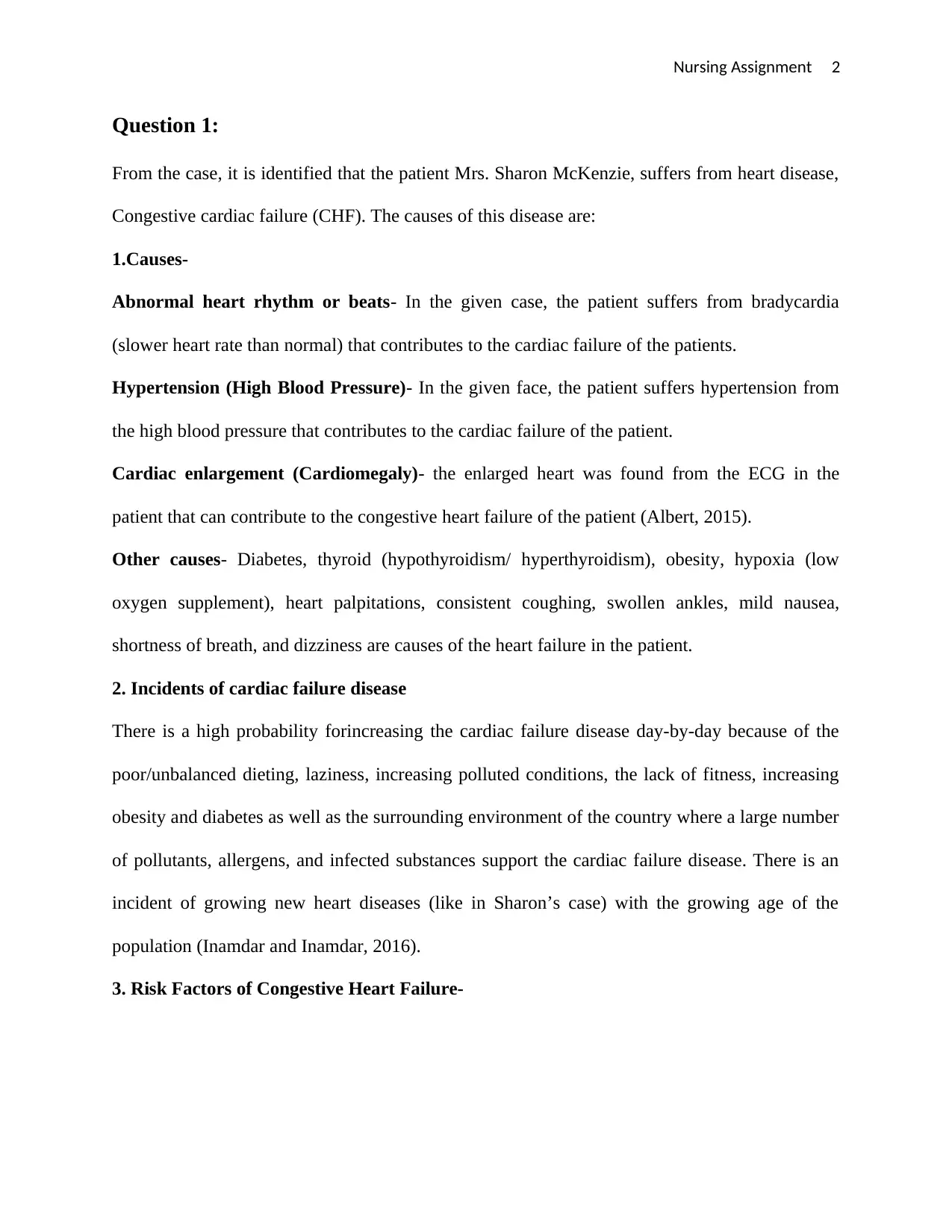
Nursing Assignment 2
Question 1:
From the case, it is identified that the patient Mrs. Sharon McKenzie, suffers from heart disease,
Congestive cardiac failure (CHF). The causes of this disease are:
1.Causes-
Abnormal heart rhythm or beats- In the given case, the patient suffers from bradycardia
(slower heart rate than normal) that contributes to the cardiac failure of the patients.
Hypertension (High Blood Pressure)- In the given face, the patient suffers hypertension from
the high blood pressure that contributes to the cardiac failure of the patient.
Cardiac enlargement (Cardiomegaly)- the enlarged heart was found from the ECG in the
patient that can contribute to the congestive heart failure of the patient (Albert, 2015).
Other causes- Diabetes, thyroid (hypothyroidism/ hyperthyroidism), obesity, hypoxia (low
oxygen supplement), heart palpitations, consistent coughing, swollen ankles, mild nausea,
shortness of breath, and dizziness are causes of the heart failure in the patient.
2. Incidents of cardiac failure disease
There is a high probability forincreasing the cardiac failure disease day-by-day because of the
poor/unbalanced dieting, laziness, increasing polluted conditions, the lack of fitness, increasing
obesity and diabetes as well as the surrounding environment of the country where a large number
of pollutants, allergens, and infected substances support the cardiac failure disease. There is an
incident of growing new heart diseases (like in Sharon’s case) with the growing age of the
population (Inamdar and Inamdar, 2016).
3. Risk Factors of Congestive Heart Failure-
Question 1:
From the case, it is identified that the patient Mrs. Sharon McKenzie, suffers from heart disease,
Congestive cardiac failure (CHF). The causes of this disease are:
1.Causes-
Abnormal heart rhythm or beats- In the given case, the patient suffers from bradycardia
(slower heart rate than normal) that contributes to the cardiac failure of the patients.
Hypertension (High Blood Pressure)- In the given face, the patient suffers hypertension from
the high blood pressure that contributes to the cardiac failure of the patient.
Cardiac enlargement (Cardiomegaly)- the enlarged heart was found from the ECG in the
patient that can contribute to the congestive heart failure of the patient (Albert, 2015).
Other causes- Diabetes, thyroid (hypothyroidism/ hyperthyroidism), obesity, hypoxia (low
oxygen supplement), heart palpitations, consistent coughing, swollen ankles, mild nausea,
shortness of breath, and dizziness are causes of the heart failure in the patient.
2. Incidents of cardiac failure disease
There is a high probability forincreasing the cardiac failure disease day-by-day because of the
poor/unbalanced dieting, laziness, increasing polluted conditions, the lack of fitness, increasing
obesity and diabetes as well as the surrounding environment of the country where a large number
of pollutants, allergens, and infected substances support the cardiac failure disease. There is an
incident of growing new heart diseases (like in Sharon’s case) with the growing age of the
population (Inamdar and Inamdar, 2016).
3. Risk Factors of Congestive Heart Failure-

Nursing Assignment 3
Sudden heart Attacks- The CHF can result in sudden heart attacks that is a serious medical
condition of myocardial infarction in which the sudden supply of the blood to heart is stopped
because of the blood clotting.
Coronary artery diseases- this type of risks/ disease can result in dilated muscles of narrowing
arteries because of insufficient supply of oxygen to the blood in the heart and moreover
weakening of the heart muscles
Medications- the medications currently used for treating the heart disease can also lead to other
body problems because of their side effects on the body, like kidney failure to proper
functioning, lungs problems, or liver function problems (Mangoni, &Jarmuzewska, 2019).
Other risks- cardiac enlargement can increase risks to the patient, like coronary artery diseases,
abnormal heart rates, weaken (swelling/ thickening of the heart muscles, heart valve problems,
coronary artery diseases, and dilating chambers of the heart because of the chronic heart failure
of the patient.
Figure: Risk Factors of CHF
(Source: Mangoni, &Jarmuzewska, 2019)
Sudden heart Attacks- The CHF can result in sudden heart attacks that is a serious medical
condition of myocardial infarction in which the sudden supply of the blood to heart is stopped
because of the blood clotting.
Coronary artery diseases- this type of risks/ disease can result in dilated muscles of narrowing
arteries because of insufficient supply of oxygen to the blood in the heart and moreover
weakening of the heart muscles
Medications- the medications currently used for treating the heart disease can also lead to other
body problems because of their side effects on the body, like kidney failure to proper
functioning, lungs problems, or liver function problems (Mangoni, &Jarmuzewska, 2019).
Other risks- cardiac enlargement can increase risks to the patient, like coronary artery diseases,
abnormal heart rates, weaken (swelling/ thickening of the heart muscles, heart valve problems,
coronary artery diseases, and dilating chambers of the heart because of the chronic heart failure
of the patient.
Figure: Risk Factors of CHF
(Source: Mangoni, &Jarmuzewska, 2019)
⊘ This is a preview!⊘
Do you want full access?
Subscribe today to unlock all pages.

Trusted by 1+ million students worldwide
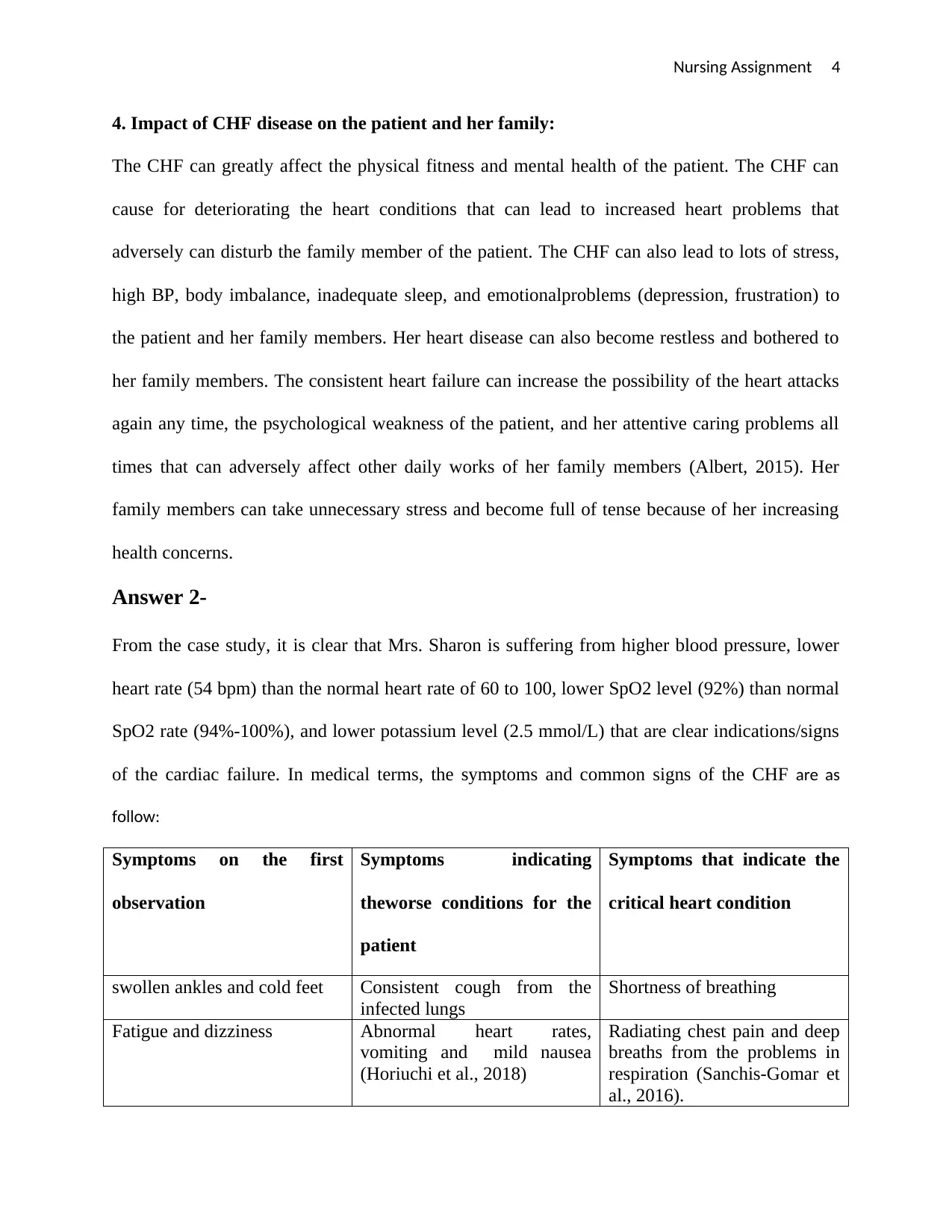
Nursing Assignment 4
4. Impact of CHF disease on the patient and her family:
The CHF can greatly affect the physical fitness and mental health of the patient. The CHF can
cause for deteriorating the heart conditions that can lead to increased heart problems that
adversely can disturb the family member of the patient. The CHF can also lead to lots of stress,
high BP, body imbalance, inadequate sleep, and emotionalproblems (depression, frustration) to
the patient and her family members. Her heart disease can also become restless and bothered to
her family members. The consistent heart failure can increase the possibility of the heart attacks
again any time, the psychological weakness of the patient, and her attentive caring problems all
times that can adversely affect other daily works of her family members (Albert, 2015). Her
family members can take unnecessary stress and become full of tense because of her increasing
health concerns.
Answer 2-
From the case study, it is clear that Mrs. Sharon is suffering from higher blood pressure, lower
heart rate (54 bpm) than the normal heart rate of 60 to 100, lower SpO2 level (92%) than normal
SpO2 rate (94%-100%), and lower potassium level (2.5 mmol/L) that are clear indications/signs
of the cardiac failure. In medical terms, the symptoms and common signs of the CHF are as
follow:
Symptoms on the first
observation
Symptoms indicating
theworse conditions for the
patient
Symptoms that indicate the
critical heart condition
swollen ankles and cold feet Consistent cough from the
infected lungs
Shortness of breathing
Fatigue and dizziness Abnormal heart rates,
vomiting and mild nausea
(Horiuchi et al., 2018)
Radiating chest pain and deep
breaths from the problems in
respiration (Sanchis-Gomar et
al., 2016).
4. Impact of CHF disease on the patient and her family:
The CHF can greatly affect the physical fitness and mental health of the patient. The CHF can
cause for deteriorating the heart conditions that can lead to increased heart problems that
adversely can disturb the family member of the patient. The CHF can also lead to lots of stress,
high BP, body imbalance, inadequate sleep, and emotionalproblems (depression, frustration) to
the patient and her family members. Her heart disease can also become restless and bothered to
her family members. The consistent heart failure can increase the possibility of the heart attacks
again any time, the psychological weakness of the patient, and her attentive caring problems all
times that can adversely affect other daily works of her family members (Albert, 2015). Her
family members can take unnecessary stress and become full of tense because of her increasing
health concerns.
Answer 2-
From the case study, it is clear that Mrs. Sharon is suffering from higher blood pressure, lower
heart rate (54 bpm) than the normal heart rate of 60 to 100, lower SpO2 level (92%) than normal
SpO2 rate (94%-100%), and lower potassium level (2.5 mmol/L) that are clear indications/signs
of the cardiac failure. In medical terms, the symptoms and common signs of the CHF are as
follow:
Symptoms on the first
observation
Symptoms indicating
theworse conditions for the
patient
Symptoms that indicate the
critical heart condition
swollen ankles and cold feet Consistent cough from the
infected lungs
Shortness of breathing
Fatigue and dizziness Abnormal heart rates,
vomiting and mild nausea
(Horiuchi et al., 2018)
Radiating chest pain and deep
breaths from the problems in
respiration (Sanchis-Gomar et
al., 2016).
Paraphrase This Document
Need a fresh take? Get an instant paraphrase of this document with our AI Paraphraser
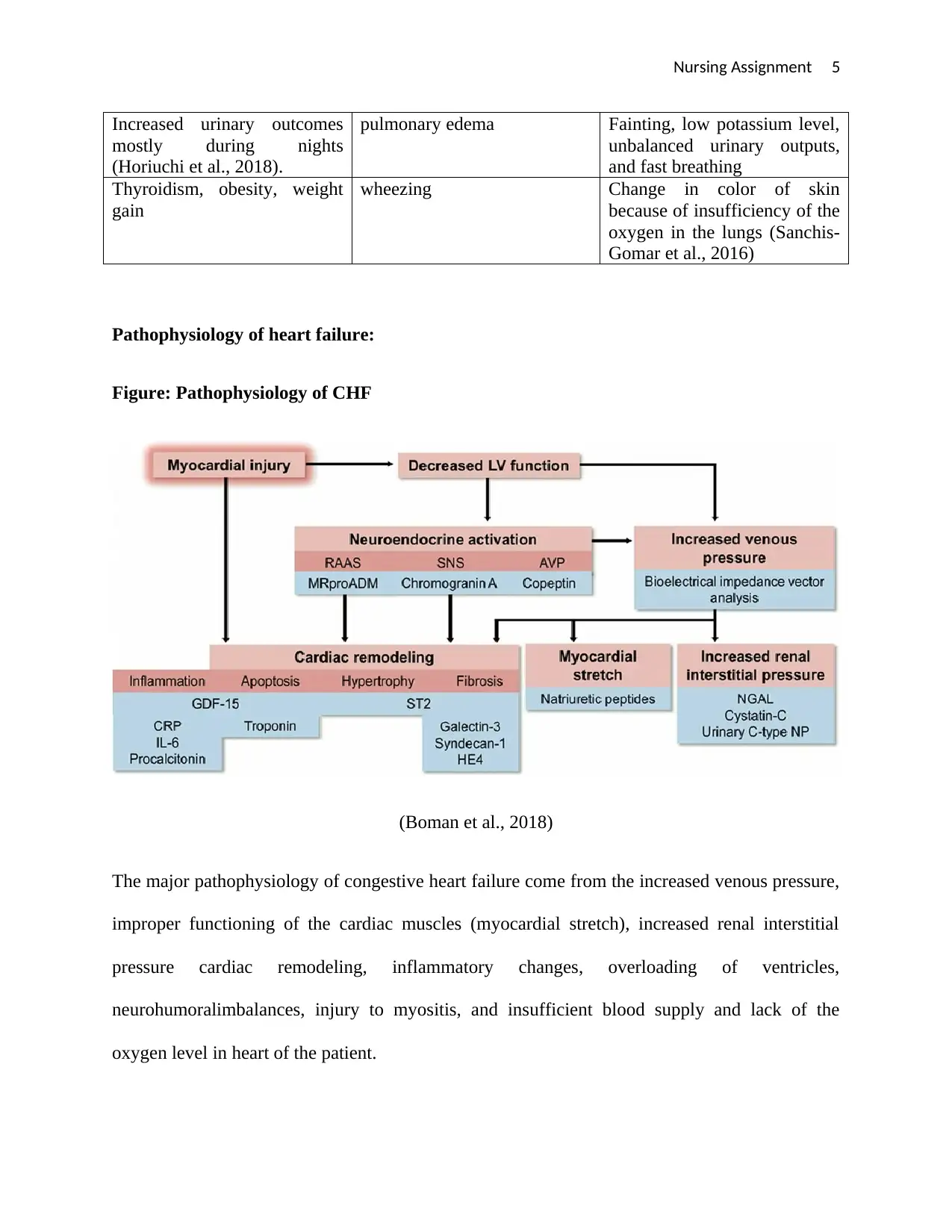
Nursing Assignment 5
Increased urinary outcomes
mostly during nights
(Horiuchi et al., 2018).
pulmonary edema Fainting, low potassium level,
unbalanced urinary outputs,
and fast breathing
Thyroidism, obesity, weight
gain
wheezing Change in color of skin
because of insufficiency of the
oxygen in the lungs (Sanchis-
Gomar et al., 2016)
Pathophysiology of heart failure:
Figure: Pathophysiology of CHF
(Boman et al., 2018)
The major pathophysiology of congestive heart failure come from the increased venous pressure,
improper functioning of the cardiac muscles (myocardial stretch), increased renal interstitial
pressure cardiac remodeling, inflammatory changes, overloading of ventricles,
neurohumoralimbalances, injury to myositis, and insufficient blood supply and lack of the
oxygen level in heart of the patient.
Increased urinary outcomes
mostly during nights
(Horiuchi et al., 2018).
pulmonary edema Fainting, low potassium level,
unbalanced urinary outputs,
and fast breathing
Thyroidism, obesity, weight
gain
wheezing Change in color of skin
because of insufficiency of the
oxygen in the lungs (Sanchis-
Gomar et al., 2016)
Pathophysiology of heart failure:
Figure: Pathophysiology of CHF
(Boman et al., 2018)
The major pathophysiology of congestive heart failure come from the increased venous pressure,
improper functioning of the cardiac muscles (myocardial stretch), increased renal interstitial
pressure cardiac remodeling, inflammatory changes, overloading of ventricles,
neurohumoralimbalances, injury to myositis, and insufficient blood supply and lack of the
oxygen level in heart of the patient.
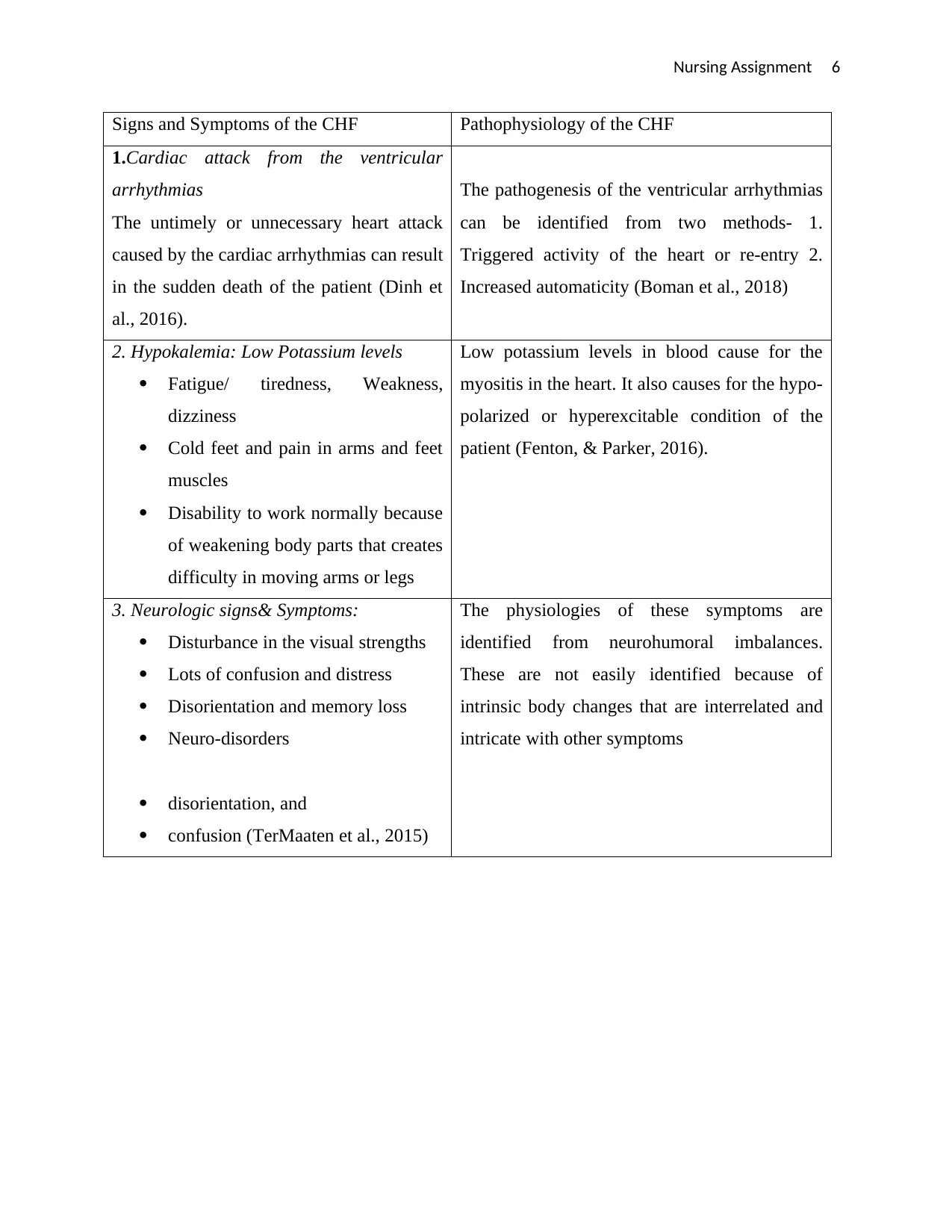
Nursing Assignment 6
Signs and Symptoms of the CHF Pathophysiology of the CHF
1.Cardiac attack from the ventricular
arrhythmias
The untimely or unnecessary heart attack
caused by the cardiac arrhythmias can result
in the sudden death of the patient (Dinh et
al., 2016).
The pathogenesis of the ventricular arrhythmias
can be identified from two methods- 1.
Triggered activity of the heart or re-entry 2.
Increased automaticity (Boman et al., 2018)
2. Hypokalemia: Low Potassium levels
Fatigue/ tiredness, Weakness,
dizziness
Cold feet and pain in arms and feet
muscles
Disability to work normally because
of weakening body parts that creates
difficulty in moving arms or legs
Low potassium levels in blood cause for the
myositis in the heart. It also causes for the hypo-
polarized or hyperexcitable condition of the
patient (Fenton, & Parker, 2016).
3. Neurologic signs& Symptoms:
Disturbance in the visual strengths
Lots of confusion and distress
Disorientation and memory loss
Neuro-disorders
disorientation, and
confusion (TerMaaten et al., 2015)
The physiologies of these symptoms are
identified from neurohumoral imbalances.
These are not easily identified because of
intrinsic body changes that are interrelated and
intricate with other symptoms
Signs and Symptoms of the CHF Pathophysiology of the CHF
1.Cardiac attack from the ventricular
arrhythmias
The untimely or unnecessary heart attack
caused by the cardiac arrhythmias can result
in the sudden death of the patient (Dinh et
al., 2016).
The pathogenesis of the ventricular arrhythmias
can be identified from two methods- 1.
Triggered activity of the heart or re-entry 2.
Increased automaticity (Boman et al., 2018)
2. Hypokalemia: Low Potassium levels
Fatigue/ tiredness, Weakness,
dizziness
Cold feet and pain in arms and feet
muscles
Disability to work normally because
of weakening body parts that creates
difficulty in moving arms or legs
Low potassium levels in blood cause for the
myositis in the heart. It also causes for the hypo-
polarized or hyperexcitable condition of the
patient (Fenton, & Parker, 2016).
3. Neurologic signs& Symptoms:
Disturbance in the visual strengths
Lots of confusion and distress
Disorientation and memory loss
Neuro-disorders
disorientation, and
confusion (TerMaaten et al., 2015)
The physiologies of these symptoms are
identified from neurohumoral imbalances.
These are not easily identified because of
intrinsic body changes that are interrelated and
intricate with other symptoms
⊘ This is a preview!⊘
Do you want full access?
Subscribe today to unlock all pages.

Trusted by 1+ million students worldwide
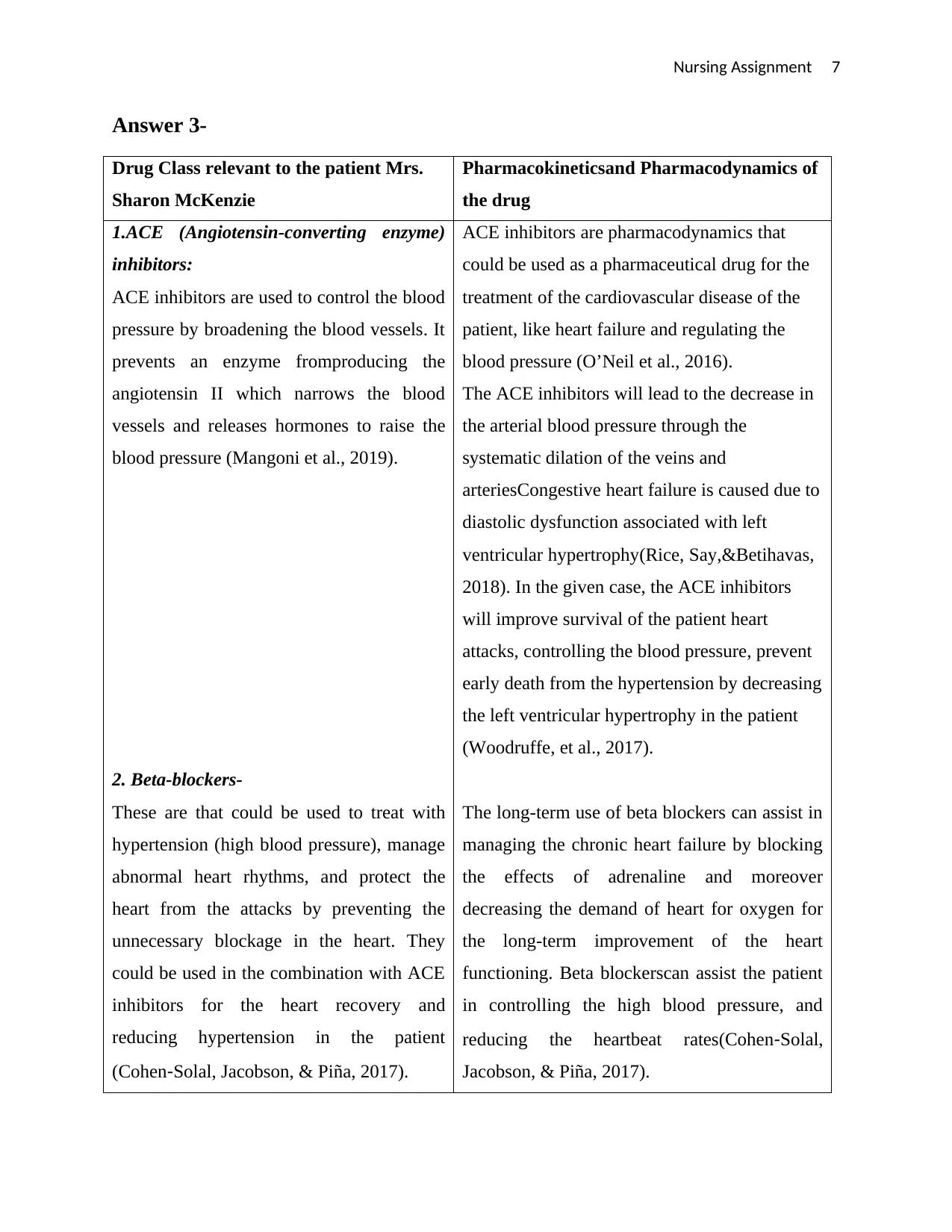
Nursing Assignment 7
Answer 3-
Drug Class relevant to the patient Mrs.
Sharon McKenzie
Pharmacokineticsand Pharmacodynamics of
the drug
1.ACE (Angiotensin-converting enzyme)
inhibitors:
ACE inhibitors are used to control the blood
pressure by broadening the blood vessels. It
prevents an enzyme fromproducing the
angiotensin II which narrows the blood
vessels and releases hormones to raise the
blood pressure (Mangoni et al., 2019).
2. Beta-blockers-
These are that could be used to treat with
hypertension (high blood pressure), manage
abnormal heart rhythms, and protect the
heart from the attacks by preventing the
unnecessary blockage in the heart. They
could be used in the combination with ACE
inhibitors for the heart recovery and
reducing hypertension in the patient
(Cohen‐Solal, Jacobson, & Piña, 2017).
ACE inhibitors are pharmacodynamics that
could be used as a pharmaceutical drug for the
treatment of the cardiovascular disease of the
patient, like heart failure and regulating the
blood pressure (O’Neil et al., 2016).
The ACE inhibitors will lead to the decrease in
the arterial blood pressure through the
systematic dilation of the veins and
arteriesCongestive heart failure is caused due to
diastolic dysfunction associated with left
ventricular hypertrophy(Rice, Say,&Betihavas,
2018). In the given case, the ACE inhibitors
will improve survival of the patient heart
attacks, controlling the blood pressure, prevent
early death from the hypertension by decreasing
the left ventricular hypertrophy in the patient
(Woodruffe, et al., 2017).
The long-term use of beta blockers can assist in
managing the chronic heart failure by blocking
the effects of adrenaline and moreover
decreasing the demand of heart for oxygen for
the long-term improvement of the heart
functioning. Beta blockerscan assist the patient
in controlling the high blood pressure, and
reducing the heartbeat rates(Cohen‐Solal,
Jacobson, & Piña, 2017).
Answer 3-
Drug Class relevant to the patient Mrs.
Sharon McKenzie
Pharmacokineticsand Pharmacodynamics of
the drug
1.ACE (Angiotensin-converting enzyme)
inhibitors:
ACE inhibitors are used to control the blood
pressure by broadening the blood vessels. It
prevents an enzyme fromproducing the
angiotensin II which narrows the blood
vessels and releases hormones to raise the
blood pressure (Mangoni et al., 2019).
2. Beta-blockers-
These are that could be used to treat with
hypertension (high blood pressure), manage
abnormal heart rhythms, and protect the
heart from the attacks by preventing the
unnecessary blockage in the heart. They
could be used in the combination with ACE
inhibitors for the heart recovery and
reducing hypertension in the patient
(Cohen‐Solal, Jacobson, & Piña, 2017).
ACE inhibitors are pharmacodynamics that
could be used as a pharmaceutical drug for the
treatment of the cardiovascular disease of the
patient, like heart failure and regulating the
blood pressure (O’Neil et al., 2016).
The ACE inhibitors will lead to the decrease in
the arterial blood pressure through the
systematic dilation of the veins and
arteriesCongestive heart failure is caused due to
diastolic dysfunction associated with left
ventricular hypertrophy(Rice, Say,&Betihavas,
2018). In the given case, the ACE inhibitors
will improve survival of the patient heart
attacks, controlling the blood pressure, prevent
early death from the hypertension by decreasing
the left ventricular hypertrophy in the patient
(Woodruffe, et al., 2017).
The long-term use of beta blockers can assist in
managing the chronic heart failure by blocking
the effects of adrenaline and moreover
decreasing the demand of heart for oxygen for
the long-term improvement of the heart
functioning. Beta blockerscan assist the patient
in controlling the high blood pressure, and
reducing the heartbeat rates(Cohen‐Solal,
Jacobson, & Piña, 2017).
Paraphrase This Document
Need a fresh take? Get an instant paraphrase of this document with our AI Paraphraser
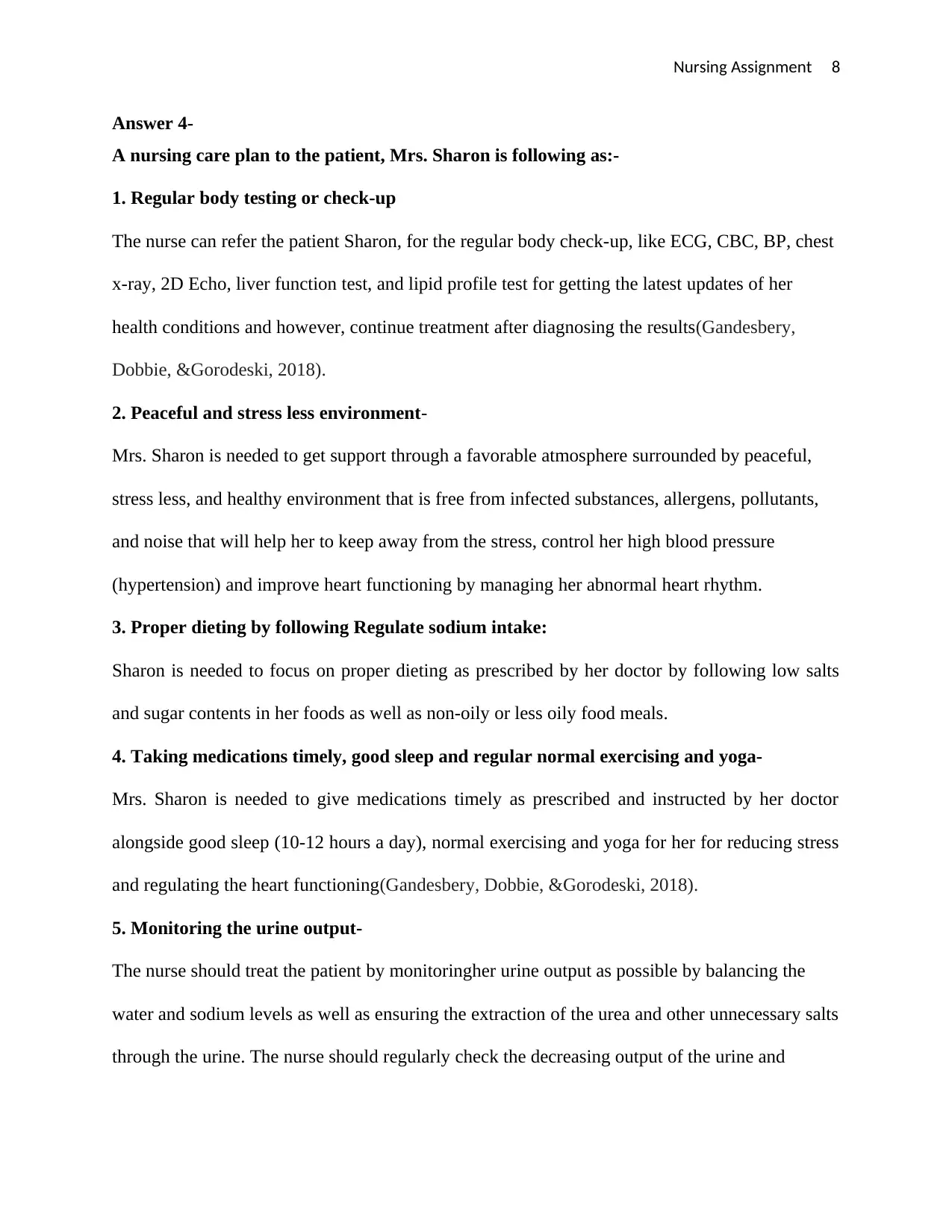
Nursing Assignment 8
Answer 4-
A nursing care plan to the patient, Mrs. Sharon is following as:-
1. Regular body testing or check-up
The nurse can refer the patient Sharon, for the regular body check-up, like ECG, CBC, BP, chest
x-ray, 2D Echo, liver function test, and lipid profile test for getting the latest updates of her
health conditions and however, continue treatment after diagnosing the results(Gandesbery,
Dobbie, &Gorodeski, 2018).
2. Peaceful and stress less environment-
Mrs. Sharon is needed to get support through a favorable atmosphere surrounded by peaceful,
stress less, and healthy environment that is free from infected substances, allergens, pollutants,
and noise that will help her to keep away from the stress, control her high blood pressure
(hypertension) and improve heart functioning by managing her abnormal heart rhythm.
3. Proper dieting by following Regulate sodium intake:
Sharon is needed to focus on proper dieting as prescribed by her doctor by following low salts
and sugar contents in her foods as well as non-oily or less oily food meals.
4. Taking medications timely, good sleep and regular normal exercising and yoga-
Mrs. Sharon is needed to give medications timely as prescribed and instructed by her doctor
alongside good sleep (10-12 hours a day), normal exercising and yoga for her for reducing stress
and regulating the heart functioning(Gandesbery, Dobbie, &Gorodeski, 2018).
5. Monitoring the urine output-
The nurse should treat the patient by monitoringher urine output as possible by balancing the
water and sodium levels as well as ensuring the extraction of the urea and other unnecessary salts
through the urine. The nurse should regularly check the decreasing output of the urine and
Answer 4-
A nursing care plan to the patient, Mrs. Sharon is following as:-
1. Regular body testing or check-up
The nurse can refer the patient Sharon, for the regular body check-up, like ECG, CBC, BP, chest
x-ray, 2D Echo, liver function test, and lipid profile test for getting the latest updates of her
health conditions and however, continue treatment after diagnosing the results(Gandesbery,
Dobbie, &Gorodeski, 2018).
2. Peaceful and stress less environment-
Mrs. Sharon is needed to get support through a favorable atmosphere surrounded by peaceful,
stress less, and healthy environment that is free from infected substances, allergens, pollutants,
and noise that will help her to keep away from the stress, control her high blood pressure
(hypertension) and improve heart functioning by managing her abnormal heart rhythm.
3. Proper dieting by following Regulate sodium intake:
Sharon is needed to focus on proper dieting as prescribed by her doctor by following low salts
and sugar contents in her foods as well as non-oily or less oily food meals.
4. Taking medications timely, good sleep and regular normal exercising and yoga-
Mrs. Sharon is needed to give medications timely as prescribed and instructed by her doctor
alongside good sleep (10-12 hours a day), normal exercising and yoga for her for reducing stress
and regulating the heart functioning(Gandesbery, Dobbie, &Gorodeski, 2018).
5. Monitoring the urine output-
The nurse should treat the patient by monitoringher urine output as possible by balancing the
water and sodium levels as well as ensuring the extraction of the urea and other unnecessary salts
through the urine. The nurse should regularly check the decreasing output of the urine and
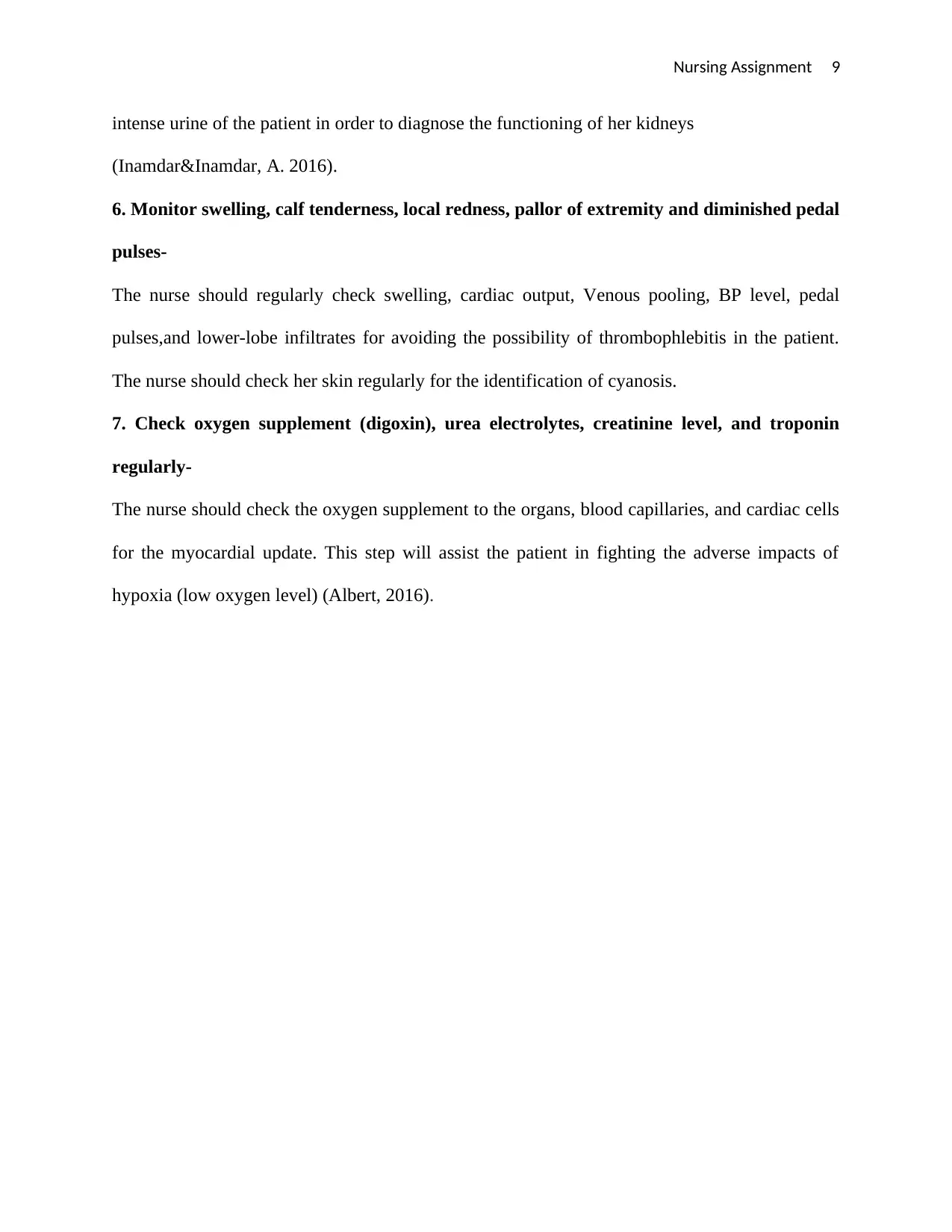
Nursing Assignment 9
intense urine of the patient in order to diagnose the functioning of her kidneys
(Inamdar&Inamdar, A. 2016).
6. Monitor swelling, calf tenderness, local redness, pallor of extremity and diminished pedal
pulses-
The nurse should regularly check swelling, cardiac output, Venous pooling, BP level, pedal
pulses,and lower-lobe infiltrates for avoiding the possibility of thrombophlebitis in the patient.
The nurse should check her skin regularly for the identification of cyanosis.
7. Check oxygen supplement (digoxin), urea electrolytes, creatinine level, and troponin
regularly-
The nurse should check the oxygen supplement to the organs, blood capillaries, and cardiac cells
for the myocardial update. This step will assist the patient in fighting the adverse impacts of
hypoxia (low oxygen level) (Albert, 2016).
intense urine of the patient in order to diagnose the functioning of her kidneys
(Inamdar&Inamdar, A. 2016).
6. Monitor swelling, calf tenderness, local redness, pallor of extremity and diminished pedal
pulses-
The nurse should regularly check swelling, cardiac output, Venous pooling, BP level, pedal
pulses,and lower-lobe infiltrates for avoiding the possibility of thrombophlebitis in the patient.
The nurse should check her skin regularly for the identification of cyanosis.
7. Check oxygen supplement (digoxin), urea electrolytes, creatinine level, and troponin
regularly-
The nurse should check the oxygen supplement to the organs, blood capillaries, and cardiac cells
for the myocardial update. This step will assist the patient in fighting the adverse impacts of
hypoxia (low oxygen level) (Albert, 2016).
⊘ This is a preview!⊘
Do you want full access?
Subscribe today to unlock all pages.

Trusted by 1+ million students worldwide
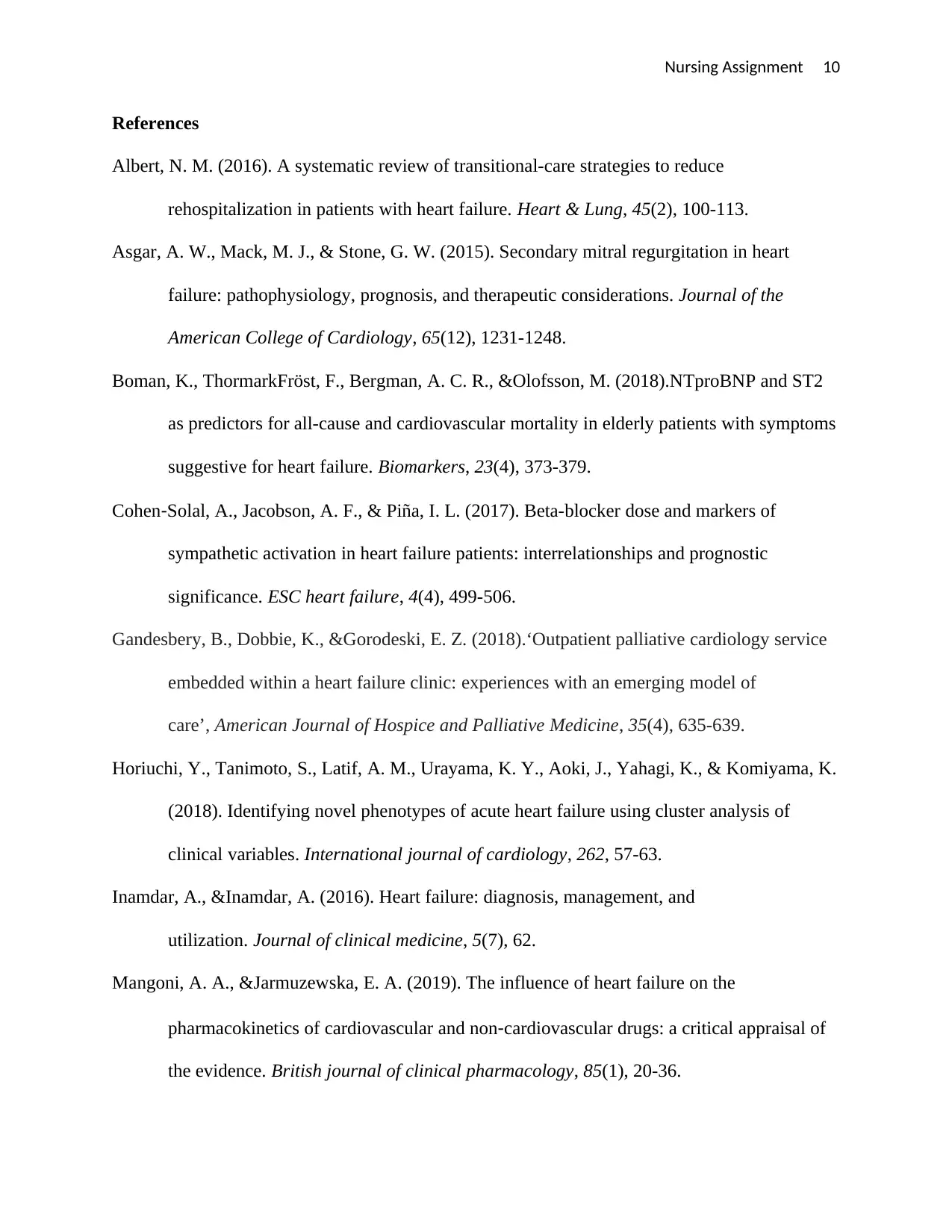
Nursing Assignment 10
References
Albert, N. M. (2016). A systematic review of transitional-care strategies to reduce
rehospitalization in patients with heart failure. Heart & Lung, 45(2), 100-113.
Asgar, A. W., Mack, M. J., & Stone, G. W. (2015). Secondary mitral regurgitation in heart
failure: pathophysiology, prognosis, and therapeutic considerations. Journal of the
American College of Cardiology, 65(12), 1231-1248.
Boman, K., ThormarkFröst, F., Bergman, A. C. R., &Olofsson, M. (2018).NTproBNP and ST2
as predictors for all-cause and cardiovascular mortality in elderly patients with symptoms
suggestive for heart failure. Biomarkers, 23(4), 373-379.
Cohen‐Solal, A., Jacobson, A. F., & Piña, I. L. (2017). Beta-blocker dose and markers of
sympathetic activation in heart failure patients: interrelationships and prognostic
significance. ESC heart failure, 4(4), 499-506.
Gandesbery, B., Dobbie, K., &Gorodeski, E. Z. (2018).‘Outpatient palliative cardiology service
embedded within a heart failure clinic: experiences with an emerging model of
care’, American Journal of Hospice and Palliative Medicine, 35(4), 635-639.
Horiuchi, Y., Tanimoto, S., Latif, A. M., Urayama, K. Y., Aoki, J., Yahagi, K., & Komiyama, K.
(2018). Identifying novel phenotypes of acute heart failure using cluster analysis of
clinical variables. International journal of cardiology, 262, 57-63.
Inamdar, A., &Inamdar, A. (2016). Heart failure: diagnosis, management, and
utilization. Journal of clinical medicine, 5(7), 62.
Mangoni, A. A., &Jarmuzewska, E. A. (2019). The influence of heart failure on the
pharmacokinetics of cardiovascular and non‐cardiovascular drugs: a critical appraisal of
the evidence. British journal of clinical pharmacology, 85(1), 20-36.
References
Albert, N. M. (2016). A systematic review of transitional-care strategies to reduce
rehospitalization in patients with heart failure. Heart & Lung, 45(2), 100-113.
Asgar, A. W., Mack, M. J., & Stone, G. W. (2015). Secondary mitral regurgitation in heart
failure: pathophysiology, prognosis, and therapeutic considerations. Journal of the
American College of Cardiology, 65(12), 1231-1248.
Boman, K., ThormarkFröst, F., Bergman, A. C. R., &Olofsson, M. (2018).NTproBNP and ST2
as predictors for all-cause and cardiovascular mortality in elderly patients with symptoms
suggestive for heart failure. Biomarkers, 23(4), 373-379.
Cohen‐Solal, A., Jacobson, A. F., & Piña, I. L. (2017). Beta-blocker dose and markers of
sympathetic activation in heart failure patients: interrelationships and prognostic
significance. ESC heart failure, 4(4), 499-506.
Gandesbery, B., Dobbie, K., &Gorodeski, E. Z. (2018).‘Outpatient palliative cardiology service
embedded within a heart failure clinic: experiences with an emerging model of
care’, American Journal of Hospice and Palliative Medicine, 35(4), 635-639.
Horiuchi, Y., Tanimoto, S., Latif, A. M., Urayama, K. Y., Aoki, J., Yahagi, K., & Komiyama, K.
(2018). Identifying novel phenotypes of acute heart failure using cluster analysis of
clinical variables. International journal of cardiology, 262, 57-63.
Inamdar, A., &Inamdar, A. (2016). Heart failure: diagnosis, management, and
utilization. Journal of clinical medicine, 5(7), 62.
Mangoni, A. A., &Jarmuzewska, E. A. (2019). The influence of heart failure on the
pharmacokinetics of cardiovascular and non‐cardiovascular drugs: a critical appraisal of
the evidence. British journal of clinical pharmacology, 85(1), 20-36.
Paraphrase This Document
Need a fresh take? Get an instant paraphrase of this document with our AI Paraphraser

Nursing Assignment 11
O’Neil, A., Fisher, A. J., Kibbey, K. J., Jacka, F. N., Kotowicz, M. A., Williams, L. J., & Pasco,
J. A. (2016). Depression is a risk factor for incident coronary heart disease in women: An
18-year longitudinal study. Journal of affective disorders, 196, 117-124.
Rice, H., Say, R., &Betihavas, V. (2018).‘The effect of nurse-led education on hospitalisation,
readmission, quality of life and cost in adults with heart failure’,A systematic
review. Patient education and counseling, 101(3), 363-374.
Ross, H., Tod, A.M. and Clarke, A. (2015).‘Understanding and Achieving Person-Centered
Care: the Nursing Perspectives’, Journal of Clinical Nursing, Vol. 24(9-10), pp. 1223-
1233.
Sahlen, K. G., Boman, K., &Brännström, M. (2016). A cost-effectiveness study of person-
centered integrated heart failure and palliative home care: based on a randomized
controlled trial. Palliative Medicine, 30(3), 296-302.
Sanchis-Gomar, F., Perez-Quilis, C., Leischik, R., & Lucia, A. (2016).Epidemiology of coronary
heart disease and acute coronary syndrome. Annals of translational medicine, 4(13).
TerMaaten, J. M., Valente, M. A., Damman, K., Hillege, H. L., Navis, G., &Voors, A. A.
(2015).Diuretic response in acute heart failure—pathophysiology, evaluation, and
therapy. Nature Reviews Cardiology, 12(3), 184.
Woodruffe, S., Neubeck, L., Clark, R. A., Gray, K., Ferry, C., Finan, J., &Briffa, T. G. (2015).
Australian Cardiovascular Health and Rehabilitation Association (ACRA) core
components of cardiovascular disease secondary prevention and cardiac rehabilitation
2014. Heart, Lung, and Circulation, 24(5), 430-441.
O’Neil, A., Fisher, A. J., Kibbey, K. J., Jacka, F. N., Kotowicz, M. A., Williams, L. J., & Pasco,
J. A. (2016). Depression is a risk factor for incident coronary heart disease in women: An
18-year longitudinal study. Journal of affective disorders, 196, 117-124.
Rice, H., Say, R., &Betihavas, V. (2018).‘The effect of nurse-led education on hospitalisation,
readmission, quality of life and cost in adults with heart failure’,A systematic
review. Patient education and counseling, 101(3), 363-374.
Ross, H., Tod, A.M. and Clarke, A. (2015).‘Understanding and Achieving Person-Centered
Care: the Nursing Perspectives’, Journal of Clinical Nursing, Vol. 24(9-10), pp. 1223-
1233.
Sahlen, K. G., Boman, K., &Brännström, M. (2016). A cost-effectiveness study of person-
centered integrated heart failure and palliative home care: based on a randomized
controlled trial. Palliative Medicine, 30(3), 296-302.
Sanchis-Gomar, F., Perez-Quilis, C., Leischik, R., & Lucia, A. (2016).Epidemiology of coronary
heart disease and acute coronary syndrome. Annals of translational medicine, 4(13).
TerMaaten, J. M., Valente, M. A., Damman, K., Hillege, H. L., Navis, G., &Voors, A. A.
(2015).Diuretic response in acute heart failure—pathophysiology, evaluation, and
therapy. Nature Reviews Cardiology, 12(3), 184.
Woodruffe, S., Neubeck, L., Clark, R. A., Gray, K., Ferry, C., Finan, J., &Briffa, T. G. (2015).
Australian Cardiovascular Health and Rehabilitation Association (ACRA) core
components of cardiovascular disease secondary prevention and cardiac rehabilitation
2014. Heart, Lung, and Circulation, 24(5), 430-441.
1 out of 11
Related Documents
Your All-in-One AI-Powered Toolkit for Academic Success.
+13062052269
info@desklib.com
Available 24*7 on WhatsApp / Email
![[object Object]](/_next/static/media/star-bottom.7253800d.svg)
Unlock your academic potential
Copyright © 2020–2025 A2Z Services. All Rights Reserved. Developed and managed by ZUCOL.




